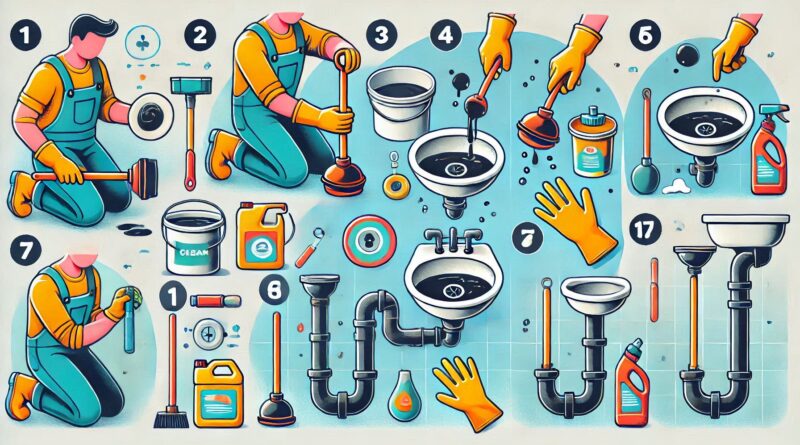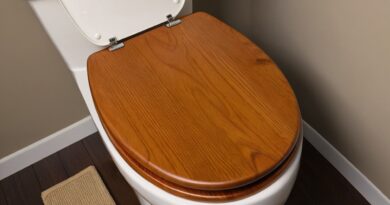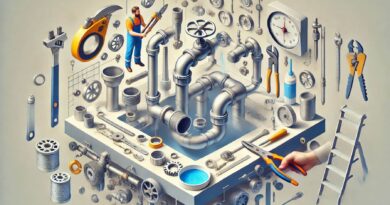How to Clean Grease from Drain Pipes Like a Pro: Simple Steps Anyone Can Follow
Have you ever noticed your kitchen sink draining slower than usual, or caught a whiff of a foul odor lingering near the pipes? These are telltale signs that grease buildup might be wreaking havoc in your drain pipes. While it’s easy to pour leftover cooking oil or grease down the sink in the rush of daily life, this seemingly harmless habit can lead to stubborn clogs, unpleasant smells, and even costly plumbing repairs. But don’t worry—cleaning grease from drain pipes doesn’t have to be a daunting task.
In this post, we’ll explore simple, effective methods to remove grease buildup from your drain pipes and prevent future clogs. From natural remedies like baking soda and vinegar to powerful enzymatic cleaners and professional-grade solutions, we’ll cover a variety of approaches to suit your needs. We’ll also share expert tips on maintaining grease-free pipes, so you can avoid costly plumber visits and keep your drains flowing smoothly.
Ready to take the plunge and tackle that pesky grease? Keep reading to discover practical steps, common mistakes to avoid, and proactive measures that will save you time, money, and frustration in the long run. Your pipes—and your wallet—will thank you!
What Exactly is clean grease from drain pipes?
Cleaning grease from drain pipes involves removing the buildup of fats, oils, and grease (commonly referred to as FOG) that accumulate over time inside your plumbing system. When grease is poured down the drain, it may initially appear to flow away smoothly, but as it cools, it solidifies and sticks to the walls of the pipes. This creates a sticky residue that traps other debris, gradually forming stubborn clogs that restrict water flow and can lead to unpleasant odors, slow drains, and even complete blockages.
The process of cleaning grease from drain pipes can include a variety of methods, such as flushing the pipes with hot water and dish soap to loosen the grease, using natural cleaning agents like baking soda and vinegar to break it down, or employing specialized products like enzymatic drain cleaners that digest the grease. In more severe cases, mechanical methods such as drain snakes or professional hydro jetting may be required.
Understanding how to clean and maintain your drain pipes not only resolves immediate issues but also helps prevent long-term damage to your plumbing system. By addressing grease buildup proactively and using best practices for disposing of fats and oils, you can ensure that your drains remain clear and functional for years to come.
Why should you clean grease from drain pipes?
Cleaning grease from drain pipes is essential for several reasons, ranging from preventing costly plumbing issues to maintaining a hygienic and odor-free environment in your home. Here’s why it’s so important to address grease buildup in your pipes:
1. Prevent Clogs and Blockages
When grease cools and hardens inside your pipes, it creates a sticky surface that traps food particles, soap scum, and other debris. Over time, this can lead to stubborn clogs that slow water flow or completely block the drain. Regular cleaning ensures that grease buildup doesn’t escalate into a major plumbing headache.
2. Avoid Costly Repairs
Ignoring grease accumulation can result in severe blockages that require professional intervention, such as drain snaking or hydro jetting, which can be expensive. In extreme cases, hardened grease may damage your pipes, leading to costly replacements. Routine maintenance is a simple and cost-effective way to protect your plumbing system.
3. Eliminate Foul Odors
Grease and food particles trapped in your drain can start to decompose, emitting unpleasant odors that waft into your kitchen or bathroom. Cleaning your pipes removes these materials, leaving your home smelling fresh and clean.
4. Protect the Environment
Allowing grease to accumulate in your pipes doesn’t just affect your home—it can also harm local sewer systems. When grease builds up in municipal wastewater systems, it can contribute to “fatbergs,” massive blockages that disrupt sewage flow and require significant resources to remove. Cleaning your drains and disposing of grease properly helps reduce this environmental impact.
By keeping your pipes grease-free, you ensure a smoothly functioning plumbing system, avoid unnecessary expenses, and contribute to a cleaner and safer environment for everyone.
More details
Cleaning grease from drain pipes is a task every homeowner or DIY enthusiast will face at some point. With my experience in plumbing and hands-on problem-solving, I can confidently say there are effective, practical ways to tackle grease buildup and keep your pipes running smoothly. Let me walk you through the methods, materials, and tools I trust for the job.
Understanding the Problem
Grease in pipes isn’t just a minor inconvenience; it’s a common culprit behind slow drains and clogs. When hot grease is poured down the sink, it cools, solidifies, and coats the pipe walls. Over time, it traps food particles and other debris, creating a thick, stubborn layer. Addressing it early is crucial to avoid major blockages.
Methods That Work
1. Hot Water and Dish Soap
This is the simplest solution and works well for minor buildup. Boil a large pot of water, mix it with a generous squirt of degreasing dish soap, and slowly pour it down the drain. The hot water melts the grease, while the soap emulsifies it, preventing it from re-solidifying. It’s a straightforward method that requires minimal tools.
Impression: This is reliable for light maintenance. It’s quick and cost-effective, but less effective for severe clogs. The key is using a soap specifically designed for cutting grease.
2. Baking Soda and Vinegar
This natural solution is a personal favorite. Pour half a cup of baking soda into the drain, followed by an equal amount of vinegar. Cover the drain and let the chemical reaction work for 10-15 minutes. Then flush with hot water.
Impression: The fizzing action is satisfying, and it’s a great eco-friendly option. It works best for moderate grease buildup but may need to be repeated for heavy clogs.
3. Enzymatic Drain Cleaners
These cleaners contain natural enzymes or bacteria that break down organic material, including grease. They’re safe for pipes and the environment. Just pour the cleaner down the drain and let it sit overnight for the best results.
Impression: I highly recommend this for maintenance. It’s gentle yet effective, and I appreciate the long-term benefits of preventing future buildup. However, patience is required, as results aren’t immediate.
4. Plumber’s Snake or Auger
For severe clogs, mechanical tools like a plumber’s snake can physically remove grease and debris. Insert the snake into the pipe, crank the handle, and pull out the blockage.
Impression: This is highly effective for tough clogs but requires effort and some know-how. It’s a go-to tool for plumbers and should be in every DIYer’s toolkit.
Materials and Tools to Have on Hand
- Degreasing dish soap
- Baking soda and vinegar
- Enzymatic drain cleaner
- Plumber’s snake or drain auger
- Rubber gloves
- Boiling water (always be cautious when handling hot water)
Maintenance Tips
Preventative care is the best way to avoid grease buildup. Never pour grease down the drain; instead, collect it in a container and dispose of it in the trash. Regularly flushing your pipes with hot water and dish soap can also help maintain a clean system.
By combining these methods and tools, you can tackle grease buildup confidently. Each approach has its strengths, so choose the one that best suits your situation. Keeping your drains grease-free is not only manageable but also essential for the longevity of your plumbing system.
Here’s a detailed look at each ingredient used in grease removal, their properties, and how they perform in different situations. Afterward, I’ll present a comparison table to summarize their effectiveness, eco-friendliness, and suitability.
Hot Water
- Properties: Hot water melts solidified grease, making it easier to flush out of the pipes.
- Effectiveness: Works well for minor, fresh grease buildup. However, it is less effective on older, hardened grease deposits.
- Ease of Use: Very simple; just boil water and pour it down the drain.
Dish Soap
- Properties: A degreasing dish soap emulsifies grease, breaking it into smaller droplets that can be washed away with water.
- Effectiveness: Works in combination with hot water but needs thorough rinsing to remove grease effectively.
- Ease of Use: Easily available and straightforward to apply.
Baking Soda
- Properties: A natural abrasive and deodorizer. It reacts with vinegar to create a chemical reaction that helps loosen grease.
- Effectiveness: Ideal for mild to moderate grease buildup. Needs repeated applications for severe blockages.
- Eco-Friendliness: Completely safe for the environment and pipes.
Vinegar
- Properties: An acid that reacts with baking soda to produce fizzing bubbles, which break down grease and other organic matter.
- Effectiveness: Works well as part of the baking soda-vinegar combo. Alone, it is less effective against grease.
- Eco-Friendliness: Safe and biodegradable.
Enzymatic Drain Cleaners
- Properties: Contain enzymes or bacteria that digest organic material, including grease, over time.
- Effectiveness: Excellent for maintenance and long-term grease prevention but slower to show results.
- Eco-Friendliness: Non-toxic and safe for pipes and the environment.
Plumber’s Snake or Auger
- Properties: A mechanical tool that physically breaks up and removes grease clogs.
- Effectiveness: The best solution for severe blockages. It removes grease buildup directly and thoroughly.
- Ease of Use: Requires some skill and effort but guarantees immediate results.
Comparison Table
| Ingredient/Method | Effectiveness | Eco-Friendliness | Ease of Use | Best For |
|---|---|---|---|---|
| Hot Water | Moderate (fresh grease) | High | Very easy | Light, fresh grease buildup |
| Dish Soap | Moderate (with hot water) | High | Easy | Mild grease deposits |
| Baking Soda | Moderate | High | Easy | Mild to moderate grease buildup |
| Vinegar | Moderate | High | Easy | Mild to moderate grease buildup |
| Enzymatic Drain Cleaner | High (maintenance) | High | Easy but slow | Long-term grease prevention |
| Plumber’s Snake/Auger | Very High | High | Requires effort/skill | Severe or hardened grease blockages |
Conclusion
Each method has its advantages depending on the severity of the grease buildup and your maintenance goals. For light, routine cleaning, hot water and dish soap or the baking soda-vinegar combo are simple and effective. Enzymatic cleaners are excellent for ongoing maintenance, while a plumber’s snake is the go-to tool for tackling severe clogs.
What you need to clean drain pipes of grease?
Here’s a table of equipment needed to clean grease from drain pipes, categorized by the method you choose and including descriptions of each tool or material.
| Equipment/Material | Purpose | When to Use | Description |
|---|---|---|---|
| Boiling Pot or Kettle | To heat water for flushing grease | Hot water and dish soap method | A sturdy pot or kettle for boiling water. Larger sizes are ideal for delivering ample hot water. |
| Degreasing Dish Soap | Emulsifies grease, making it easier to flush | With hot water for minor grease buildups | A dishwashing liquid designed to cut through grease effectively. |
| Baking Soda | Natural abrasive that helps break down grease | Baking soda and vinegar method | Readily available household ingredient, safe and eco-friendly. |
| Vinegar | Reacts with baking soda to loosen grease | Baking soda and vinegar method | White vinegar or apple cider vinegar works; white vinegar is more cost-effective. |
| Measuring Cup | Ensures accurate amounts of ingredients for mixtures | Baking soda and vinegar method | Helps to measure the right proportions of baking soda and vinegar. |
| Enzymatic Drain Cleaner | Digests organic material, including grease | Long-term maintenance or minor buildups | A commercially available cleaner that’s safe for pipes and the environment. |
| Rubber Gloves | Protects hands from hot water, chemicals, and debris | Any cleaning method | Durable, waterproof gloves for safety and hygiene. |
| Plumber’s Snake (Auger) | Breaks up and removes severe grease blockages | For hardened or severe clogs | A flexible metal tool with a coiled end that manually removes obstructions. |
| Bucket | Collects dirty water or grease debris during cleaning | With plumber’s snake or for cleanup | Useful for catching water or debris when working on pipes. |
| Pipe Wrench | Loosens pipe joints for direct access to clogs | For accessing deeper blockages in pipes | A heavy-duty tool for disassembling sections of the drain system if needed. |
| Drain Plug or Cover | Helps trap steam and pressure during vinegar reaction | Baking soda and vinegar method | A simple rubber or metal cover to block the drain while the reaction occurs. |
| Flashlight | Illuminates hard-to-reach areas in pipes | When inspecting the drain manually | Handy for getting a clear view of the interior of your pipes. |
| Hydro Jet Cleaner | High-pressure water jet to clear grease and debris | Professional-level cleaning for severe buildup | A professional-grade tool for thoroughly cleaning drain pipes using high-pressure water. |
| Drain Cleaning Brush | Scrubs grease and residue from pipe walls | For minor grease buildup near drain openings | A long-handled brush designed to clean inside pipes. |
Tips for Equipment Selection
- Basic Maintenance: Hot water, dish soap, and baking soda/vinegar are cost-effective and readily available.
- Preventative Care: Enzymatic cleaners and a drain cleaning brush are ideal for keeping pipes clear over time.
- Severe Clogs: Invest in a plumber’s snake or consider renting a hydro jet cleaner for professional-level results.
- Safety First: Always wear rubber gloves and ensure proper ventilation when using cleaners or boiling water.
Having the right equipment makes cleaning grease from drain pipes more efficient and safer, no matter the severity of the problem.
Step-by-Step Guide to Clean Grease from Drain Pipes
This guide outlines several methods to clean grease from drain pipes, starting from simple solutions to more advanced ones. Choose the method that fits your situation based on the severity of the buildup.
Method 1: Hot Water and Dish Soap (For Light Buildup)
- Boil Water: Heat about 2 liters (half a gallon) of water in a pot or kettle.
- Add Dish Soap: Mix 1-2 tablespoons of a degreasing dish soap into the boiling water.
- Pour Slowly: Carefully pour the hot, soapy water down the drain in small increments.
- Flush: Run hot tap water for 1-2 minutes to rinse away any remaining grease.
- Repeat: Repeat the process if the water still drains slowly.
Method 2: Baking Soda and Vinegar (For Moderate Buildup)
- Clear the Drain: Ensure the drain is free of standing water. Remove any visible debris.
- Add Baking Soda: Pour ½ cup of baking soda directly into the drain.
- Pour Vinegar: Follow with ½ cup of white vinegar. You’ll hear fizzing as the reaction starts.
- Cover the Drain: Place a drain plug or a damp cloth over the drain to trap the reaction inside the pipe.
- Wait: Let the mixture sit for 10-15 minutes.
- Flush with Hot Water: Boil about 2 liters of water and pour it down the drain to flush away the loosened grease.
- Repeat if Needed: Repeat the process for stubborn grease deposits.
Method 3: Enzymatic Drain Cleaner (For Maintenance or Organic Buildup)
- Read the Instructions: Review the product label for specific directions.
- Apply Cleaner: Pour the recommended amount of enzymatic cleaner into the drain.
- Let It Sit: Allow the cleaner to work overnight or as specified on the label.
- Flush with Water: The next day, flush the drain with warm water to rinse away the dissolved grease.
- Use Regularly: For ongoing maintenance, apply the cleaner once a month.
Method 4: Plumber’s Snake or Auger (For Severe Clogs)
- Prepare the Area: Place a bucket under the drain trap to catch debris or water.
- Insert the Snake: Insert the end of the plumber’s snake into the drain until you feel resistance.
- Rotate and Push: Turn the handle of the snake to break up and hook onto the clog. Push the snake further into the pipe if needed.
- Remove the Snake: Slowly pull the snake out, bringing grease and debris with it.
- Clean the Trap: If the clog persists, disassemble the drain trap under the sink and manually remove grease buildup.
- Flush the Drain: After removing the clog, flush the pipe with hot water to clear any remaining residue.
Additional Tips
- Prevent Future Clogs: Avoid pouring grease, oils, or fatty substances down the drain. Use a grease container for disposal.
- Regular Maintenance: Flush your drains with hot water and dish soap weekly to minimize grease buildup.
- Stay Safe: Always wear gloves and be cautious with boiling water or strong cleaners.
Following these steps ensures a thorough and effective clean, helping your drain pipes stay clear and functional.
FAQ: How to Clean Grease from Drain Pipes
1. Why does grease clog drains?
Grease clogs drains because it solidifies when it cools, sticking to the pipe walls. Over time, it traps other debris, forming a thick, sticky blockage that restricts water flow.
2. Can I pour hot grease down the drain if I run hot water with it?
No, pouring grease down the drain, even with hot water, is not advisable. The grease will eventually cool and solidify further down the pipe, leading to clogs. Instead, dispose of grease in a container and throw it in the trash.
3. How often should I clean my drain to prevent grease buildup?
To prevent grease buildup, clean your drains once a month using hot water and dish soap, or apply an enzymatic drain cleaner as part of regular maintenance.
4. Are chemical drain cleaners safe to use on grease clogs?
Chemical drain cleaners can be effective but are often too harsh, potentially damaging your pipes, especially if they’re older or made of PVC. Enzymatic cleaners or natural methods (like baking soda and vinegar) are safer alternatives.
5. What if the grease clog doesn’t go away after trying home remedies?
If home remedies don’t resolve the issue, you may need to use a plumber’s snake to physically remove the clog. For persistent or severe blockages, consider calling a professional plumber to avoid damaging your plumbing system.
6. Can grease buildup affect my entire plumbing system?
Yes, untreated grease buildup can spread to larger sections of your plumbing, leading to more severe blockages in the main sewer line. This can cause water backups and require expensive repairs.
7. Is there a way to prevent grease from entering the drain in the first place?
Yes, prevent grease from entering your drain by:
- Wiping greasy pans with a paper towel before washing them.
- Using a grease trap or mesh drain screen to catch grease and food particles.
- Disposing of grease in a heat-safe container instead of pouring it down the sink.
8. Are enzymatic cleaners safe for septic systems?
Yes, enzymatic cleaners are safe for septic systems. They contain natural enzymes or bacteria that break down organic material without harming the beneficial bacteria in your septic tank.
9. How can I tell if grease is causing my slow drain?
Signs that grease might be the problem include:
- Slow-draining water.
- Gurgling sounds from the drain.
- Foul odors coming from the sink.
- A history of pouring grease or fatty substances down the drain.
10. What tools should I have on hand for emergency drain cleaning?
For emergencies, it’s good to have these tools:
- A plumber’s snake or drain auger.
- A sturdy pot for boiling water.
- Baking soda and vinegar for natural solutions.
- Rubber gloves to protect your hands.
This FAQ should address common concerns and help you feel prepared to tackle grease buildup in your drain pipes.




